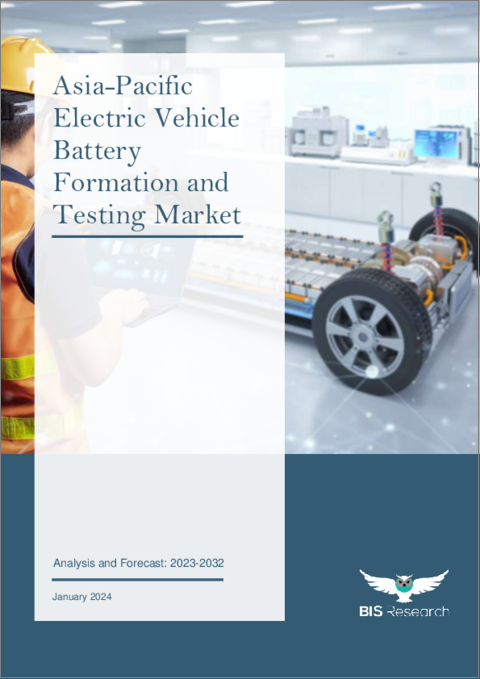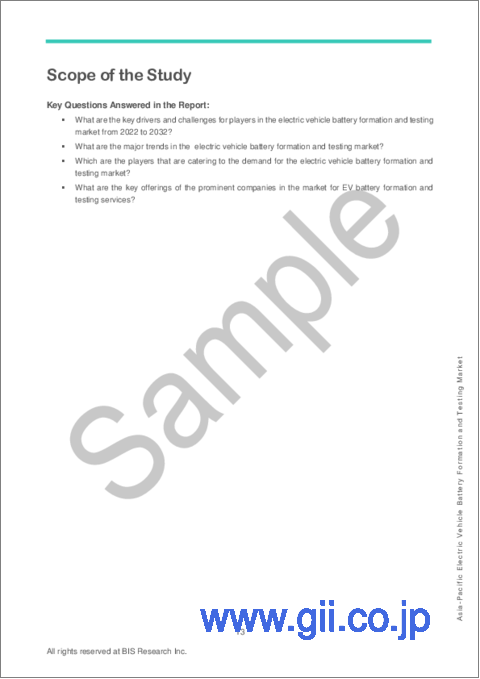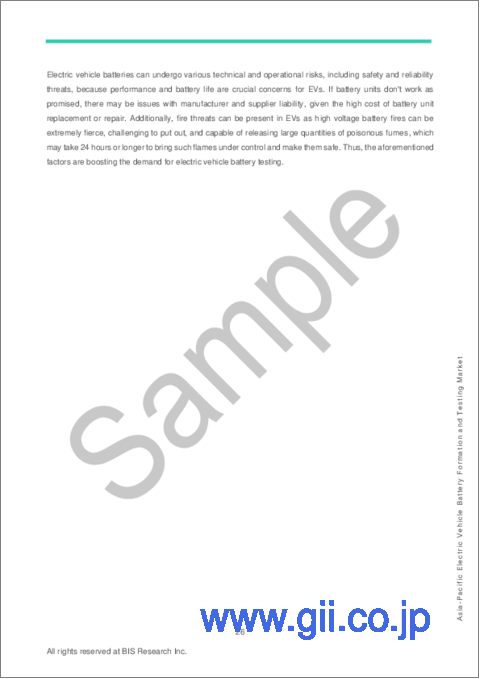|
|
市場調査レポート
商品コード
1408630
アジア太平洋の電気自動車用電池の形成と試験市場:分析と予測(2023年~2032年)Asia-Pacific Electric Vehicle Battery Formation and Testing Market: Analysis and Forecast, 2023-2032 |
||||||
カスタマイズ可能
|
|||||||
| アジア太平洋の電気自動車用電池の形成と試験市場:分析と予測(2023年~2032年) |
|
出版日: 2024年01月16日
発行: BIS Research
ページ情報: 英文 75 Pages
納期: 1~5営業日
|
全表示
- 概要
- 図表
- 目次
アジア太平洋の電気自動車用電池の形成と試験の市場規模(中国を除く)は、2023年に3,810万米ドルとなりました。
同市場は今後、24.05%のCAGRで拡大し、2032年には2億6,500万米ドルに達すると予測されています。電気自動車用電池の形成と試験市場の成長が予想されるのは、主に電気自動車(EV)の需要が増加していることと、EVバッテリーの安全性、信頼性、性能ベンチマークを維持することが急務となっているためです。EVの普及に伴い、電気自動車用バッテリーのメーカーは、最適な品質を確保しながら厳しい安全基準を遵守する製品を提供することへの期待が高まっています。
| 主要市場統計 | |
|---|---|
| 予測期間 | 2023年~2032年 |
| 2023年評価 | 3,810万米ドル |
| 2032年予測 | 2億6,500万米ドル |
| CAGR | 24.05% |
交通関連の温室効果ガス排出を抑制するための政府の取り組みに後押しされた電気自動車(EV)の需要の高まりは、EV生産の増加を促進し、それによりEVバッテリーの形成と試験サービスの必要性を増幅しています。
電池技術の継続的な進歩により、高度な電池形成・試験装置とサービスが必要となります。新しい電池化学と技術には、より高度な安全性と信頼性を確保するために、より複雑な試験手順が要求されます。
各国政府は、EVバッテリーに厳格な安全性と性能の規制を徐々に課しています。このような規制要件の増加は、電池の形成と試験サービスの需要を高め、メーカーのコンプライアンスを支援しています。
アジア太平洋の電気自動車用電池の形成と試験市場は、EVの普及加速と継続的なバッテリー技術の進化により、数年間は成長局面が続くと予想されます。しかし、市場が成熟するにつれて、試験サービス・プロバイダー間の競争激化と価格圧力の高まりを特徴とする統合段階に入るとみられます。
当レポートでは、アジア太平洋の電気自動車用電池の形成と試験市場について調査し、市場の概要とともに、用途別、車両タイプ別、電池化学別、ソーシングタイプ別、展開方法別、試験タイプ別、国別の動向、および市場に参入する企業のプロファイルなどを提供しています。
目次
エグゼクティブサマリー
調査範囲
第1章 市場
- 業界の展望
- ビジネスダイナミクス
第2章 地域
- 中国
- アジア太平洋と日本
- アジア太平洋と日本:国レベルの分析
第3章 市場-競合ベンチマーキングと企業プロファイル
- 競合ベンチマーキング
- 市場シェア分析
- 製品/サービスのマトリックス
- 企業プロファイル
- HORIBA, Ltd.
- その他の主要企業
第4章 調査手法
List of Figures
- Figure 1: Electric Vehicle Battery Formation and Testing Market, $Billion, 2022-2032
- Figure 2: Electric Vehicle Battery Formation and Testing Market (by Vehicle Type), $Million, 2022-2032
- Figure 3: Electric Vehicle Battery Formation and Testing Market (by Application), $Million, 2022-2032
- Figure 4: Electric Vehicle Battery Formation and Testing Market (by Battery Chemistry), $Million, 2022-2032
- Figure 5: Electric Vehicle Battery Formation and Testing Market (by Sourcing Type), $Million, 2022-2032
- Figure 6: Electric Vehicle Battery Formation and Testing Market (by Deployment Method), $Million, 2022-2032
- Figure 7: Electric Vehicle Battery Formation and Testing Market (by Testing Type), $Million, 2022-2032
- Figure 8: Electric Vehicle Battery Formation and Testing Market (by Region), 2022
- Figure 9: Technology Roadmap for Electric Vehicle Battery Formation and Testing Market
- Figure 10: Total Number of Patent Filed (by Year), January 2020-October 2023
- Figure 11: Patent Analysis (by Status), January 2020-October 2023
- Figure 12: Electric Vehicle Sales Worldwide, 2020-2028
- Figure 13: Electric Vehicle Battery Formation and Testing Market: Competitive Benchmarking, 2022
- Figure 14: HORIBA, Ltd.: Product Portfolio
- Figure 15: Research Methodology
- Figure 16: Data Triangulation
- Figure 17: Top-Down and Bottom-Up Approach
- Figure 18: Assumptions and Limitations
List of Tables
- Table 1: Electric Vehicle Battery Formation and Testing Market, Overview
- Table 2: Key Companies Profiled
- Table 3: Consortiums, Associations, and Regulatory Bodies
- Table 4: Government Initiatives
- Table 5: Programs by Research Institutions and Universities
- Table 6: Impact of Business Drivers
- Table 7: Impact of Business Restraints
- Table 8: Electric Vehicle Battery Formation and Testing Market (by Region), $Million, 2022-2032
- Table 9: Electric Vehicle Battery Formation and Testing Market Share Analysis, 2022
- Table 10: Electric Vehicle Battery Formation and Testing Market: Product Matrix
“The Asia-Pacific Electric Vehicle Battery Formation and Testing Market (excluding China) Expected to Reach $265.0 Million by 2032.”
Introduction to Asia-Pacific Electric Vehicle Battery Formation and Testing Market
The Asia-Pacific electric vehicle battery formation and testing market (excluding China) was valued at $38.1 million in 2023, and it is expected to grow at a CAGR of 24.05% and reach $265.0 million by 2032. The anticipated growth in the electric vehicle battery formation and testing market is primarily attributed to the increasing demand for Electric Vehicles (EVs) and the imperative to uphold the safety, reliability, and performance benchmarks of EV batteries. With the escalating adoption of EVs, manufacturers of electric vehicle batteries face heightened expectations to deliver products that adhere to stringent safety standards while ensuring optimal quality.
| KEY MARKET STATISTICS | |
|---|---|
| Forecast Period | 2023 - 2032 |
| 2023 Evaluation | $38.1 Million |
| 2032 Forecast | $265.0 Million |
| CAGR | 24.05% |
Market Introduction
The electric vehicle battery formation and testing market in the Asia-Pacific (APAC) region is within its growth stage. This phase is characterized by rapid expansion driven by various factors, including:
- 1. Surging EV Demand: The escalating demand for Electric Vehicles (EVs), spurred by governmental initiatives to curb transportation-related greenhouse gas emissions, fuels increased EV production, thereby amplifying the need for EV battery formation and testing services.
- 2. Requirement for Advanced Technology: Ongoing advancements in battery technology necessitate sophisticated battery formation and testing equipment and services. Emerging battery chemistries and technologies demand more intricate testing procedures to ensure heightened safety and reliability.
- 3. Stringent Regulatory Standards: Governments are progressively imposing rigorous safety and performance regulations on EV batteries. This increase in regulatory requirements elevates the demand for battery formation and testing services, aiding manufacturers in compliance.
The growth phase in the APAC electric vehicle battery formation and testing market is anticipated to persist for several years, driven by the accelerating adoption of EVs and continuous battery technology evolution. However, as the market matures, it is poised to enter the consolidation stage, characterized by heightened competition among testing service providers and increased pricing pressures.
Market Segmentation:
Segmentation 1: by Application
- Manufacturing
- Testing
Segmentation 2: by Vehicle Type
- Passenger Vehicle
- Commercial Vehicle
Segmentation 3: by Battery Chemistry
- Lithium-Ion
- Others
Segmentation 4: by Sourcing Type
- In-house
- Outsourcing
Segmentation 5: by Deployment Method
- Cloud-Based
- On-Premises
Segmentation 6: by Testing Type
- Mechanical Tests
- Thermal Tests
- Electrical Tests
- Others
Segmentation 7: by Country
- Japan
- South Korea
- India
How can this report add value to an organization?
Product/Innovation Strategy: The product/innovation strategy for companies in the electric vehicle battery formation and testing market should focus on continuous improvement, differentiated solutions, collaboration, automation, cost reduction, regulatory compliance, talent acquisition, and intellectual property protection. Companies should continuously invest in research and development to stay ahead of the curve, develop specialized testing equipment, partner with industry stakeholders, leverage automation and data analytics, focus on cost-effective battery chemistries, stay informed on regulatory standards, attract and retain top talent, and protect their intellectual property. By following these key strategies, companies can position themselves for success in this growing and dynamic market.
Growth/Marketing Strategy: The electric vehicle battery formation and testing market has been growing at a rapid pace. The market offers enormous opportunities for existing and emerging market players. Some of the strategies covered in this segment are mergers and acquisitions, product launches, partnerships and collaborations, business expansions, and investments. The strategies preferred by companies to maintain and strengthen their market position primarily include partnerships, agreements, and collaborations.
Competitive Strategy: The competitive strategy for companies in the electric vehicle battery formation and testing market should be focused on differentiation, cost leadership, and customer focus. Companies should differentiate their products and services by developing specialized testing equipment, offering value-added services, and collaborating with industry partners. They should also focus on cost reduction by developing more efficient manufacturing processes and using less expensive materials. Finally, companies should focus on providing excellent customer service and support to build strong customer relationships. By focusing on these three key areas, companies can gain a competitive edge in the electric vehicle battery formation and testing market.
Table of Contents
Executive Summary
Scope of the Study
1. Markets
- 1.1. Industry Outlook
- 1.1.1. Trends: Current and Future
- 1.1.1.1. Growing Demand for High-Performance and Reliable Electric Vehicle (EV) Batteries
- 1.1.1.2. Strategic Business Strategies to Enhance Presence in the Electric Vehicle Battery Formation and Testing Market
- 1.1.2. Technology Roadmap
- 1.1.3. Ecosystem/Ongoing Programs
- 1.1.3.1. Consortiums, Associations, and Regulatory Bodies
- 1.1.3.2. Government Initiatives
- 1.1.3.3. Programs by Research Institutions and Universities
- 1.1.4. Key Patent Mapping
- 1.1.4.1. Patent Analysis (by Status)
- 1.1.1. Trends: Current and Future
- 1.2. Business Dynamics
- 1.2.1. Business Drivers
- 1.2.1.1. Growing Adoption and Utilization of Electric Vehicles
- 1.2.1.2. Improving Electric Vehicle Performance through Accurate Battery Testing
- 1.2.1.3. Stringent Government Regulations on EV Battery Safety and Performance
- 1.2.2. Business Restraints
- 1.2.2.1. Less Adoption of EVs in Many Underdeveloped and Developing Countries
- 1.2.2.2. Supply Chain Uncertainties and Lack of Charging Infrastructure
- 1.2.3. Business Opportunities
- 1.2.3.1. Growing Usage of Emerging Technologies for Battery Testing
- 1.2.3.2. Increase in the Number of Battery Failure Cases in Electric Vehicles
- 1.2.1. Business Drivers
2. Regions
- 2.1. China
- 2.2. Asia-Pacific and Japan
- 2.2.1. Asia-Pacific and Japan: Country-Level Analysis
- 2.2.1.1. Japan
- 2.2.1.2. South Korea
- 2.2.1.3. India
- 2.2.1.4. Rest-of-Asia-Pacific and Japan
- 2.2.1. Asia-Pacific and Japan: Country-Level Analysis
3. Markets - Competitive Benchmarking & Company Profiles
- 3.1. Competitive Benchmarking
- 3.2. Market Share Analysis
- 3.3. Product/Service Matrix
- 3.4. Company Profiles
- 3.4.1. HORIBA, Ltd.
- 3.4.1.1. Company Overview
- 3.4.1.2. Product Portfolio
- 3.4.1.3. Analyst View
- 3.4.1.3.1. Regions of Growth
- 3.4.1. HORIBA, Ltd.
- 3.5. Other Key Companies
4. Research Methodology
- 4.1. Data Sources
- 4.1.1. Primary Data Sources
- 4.1.2. Secondary Data Sources
- 4.2. Data Triangulation
- 4.3. Market Estimation and Forecast
- 4.3.1. Factors for Data Prediction and Modeling





